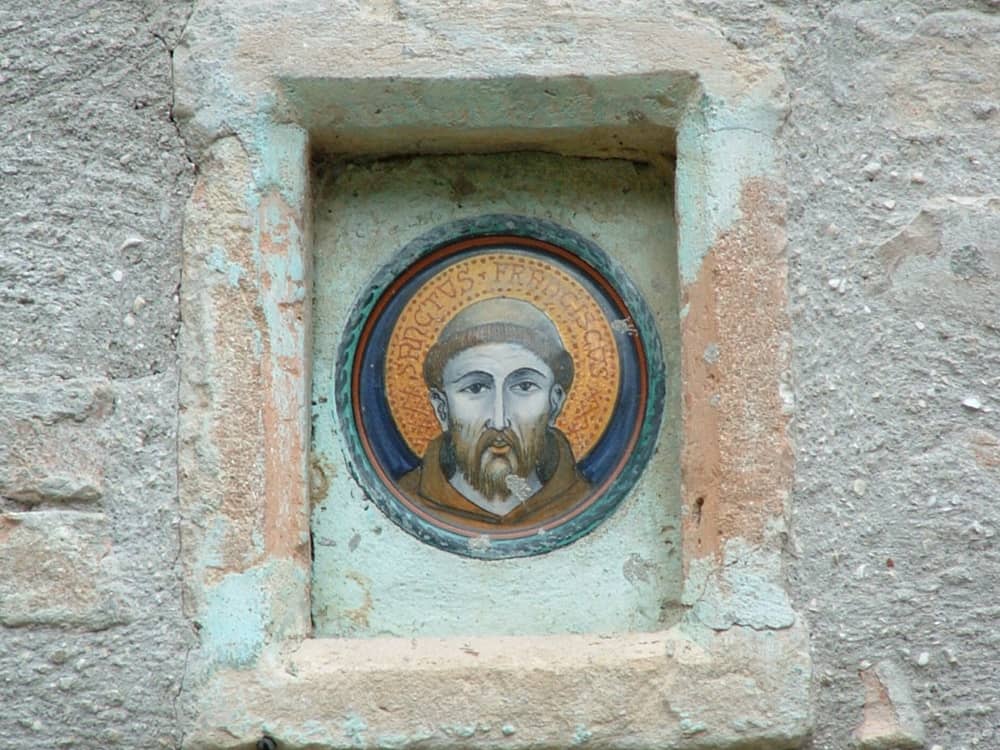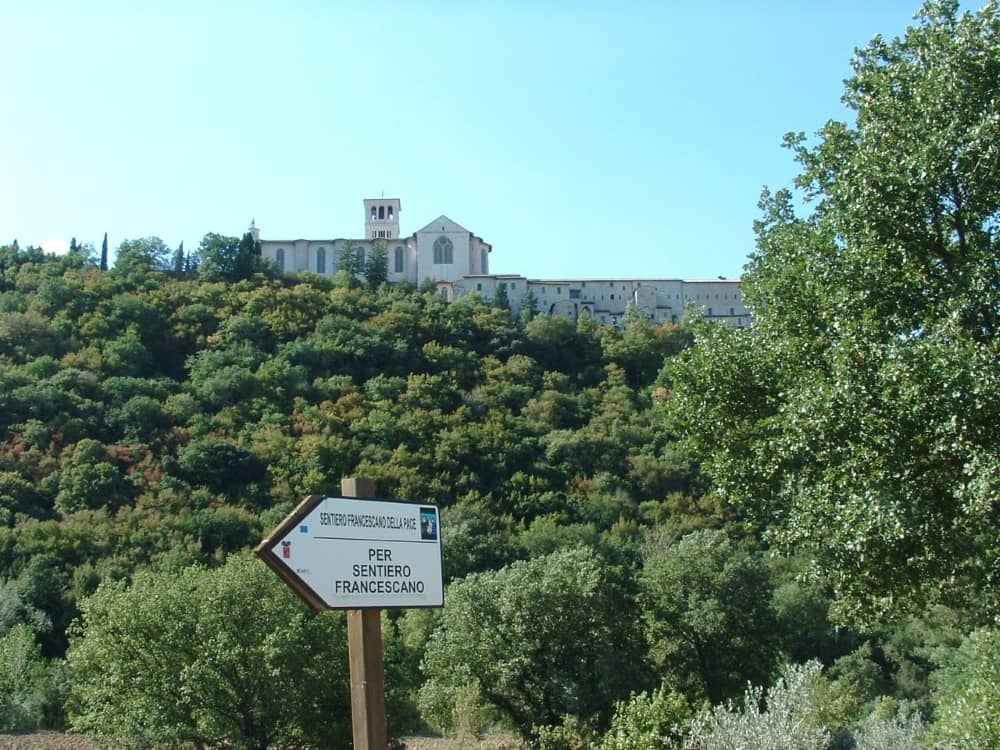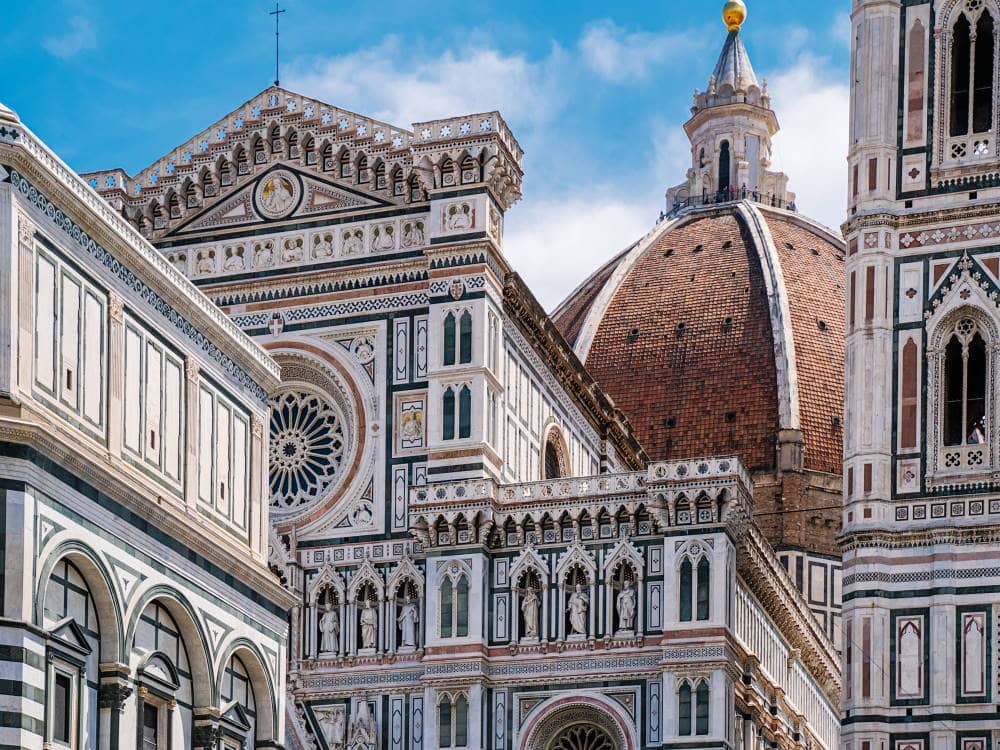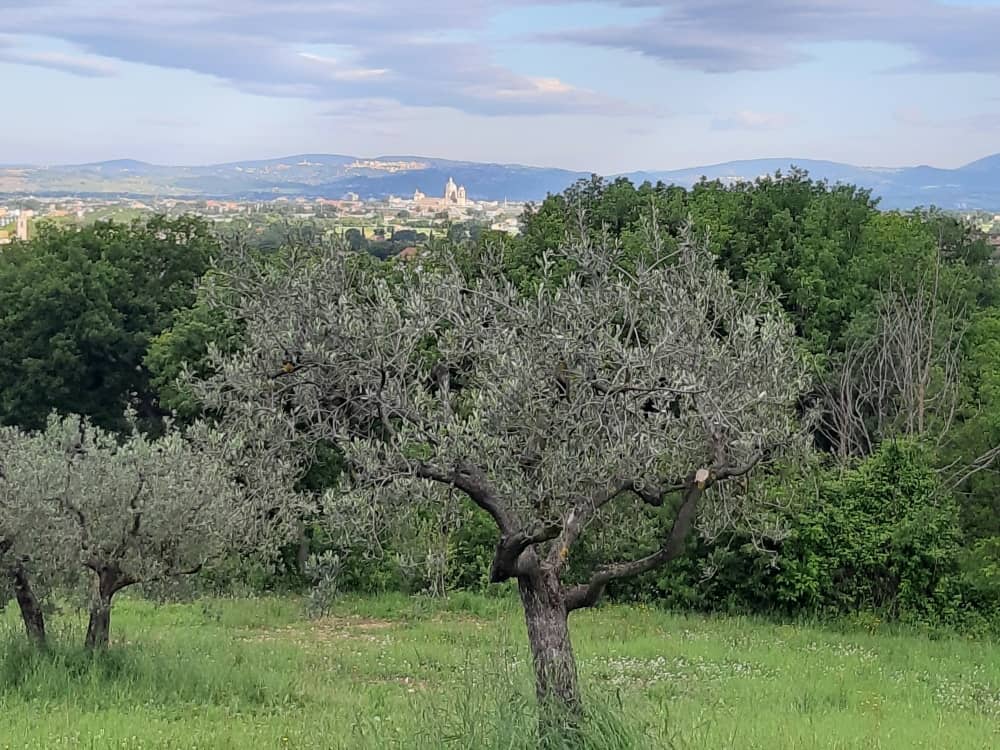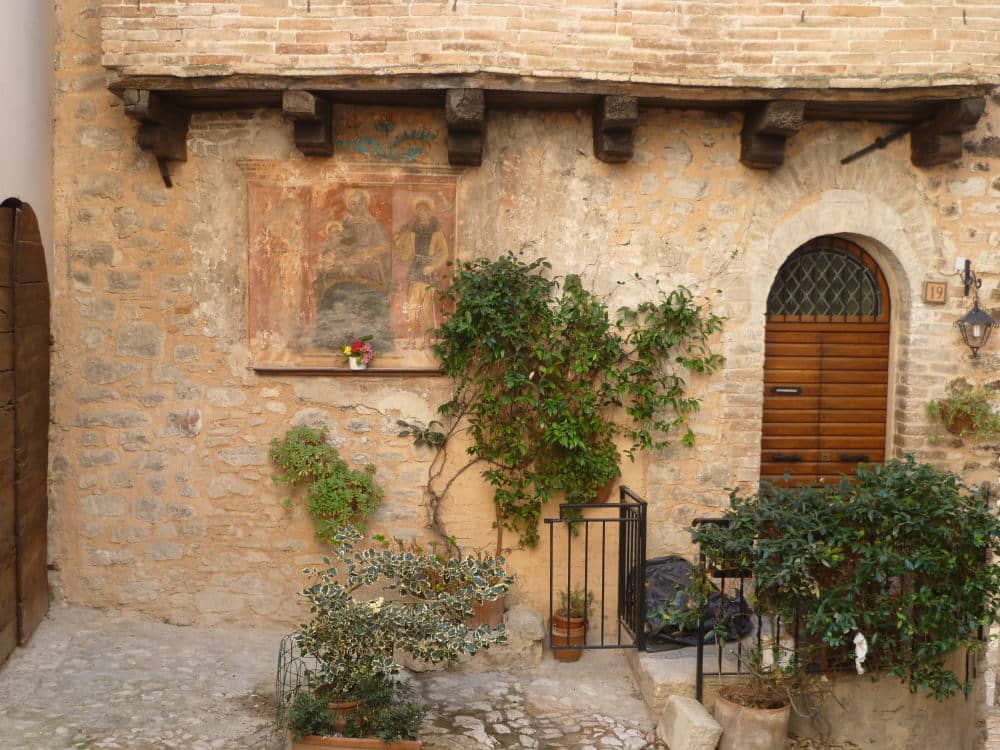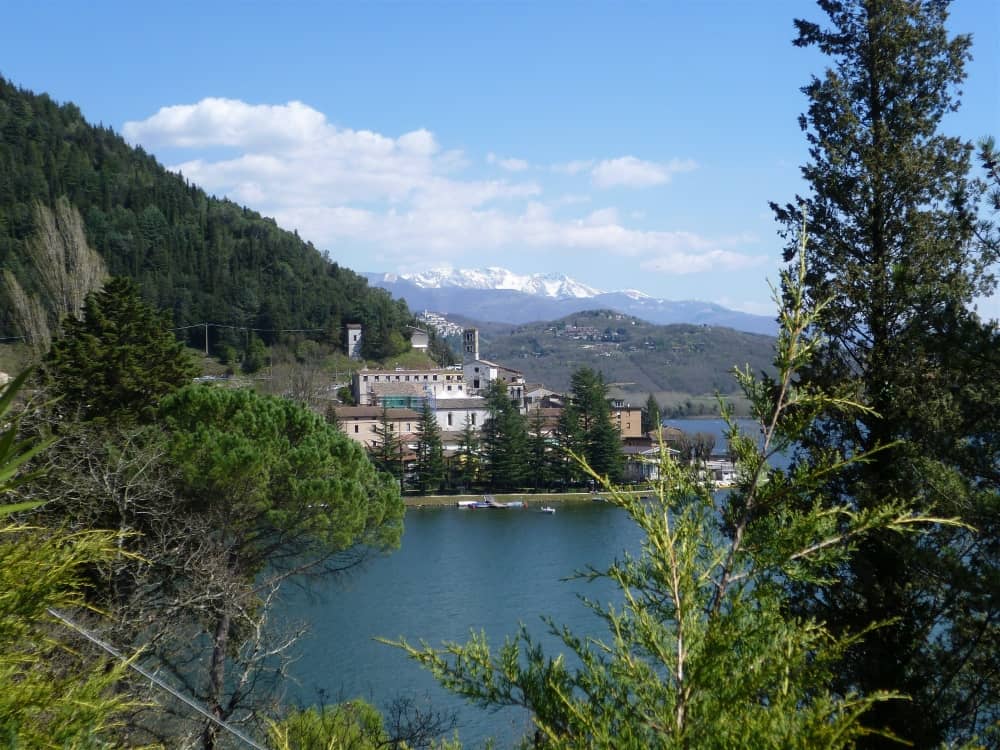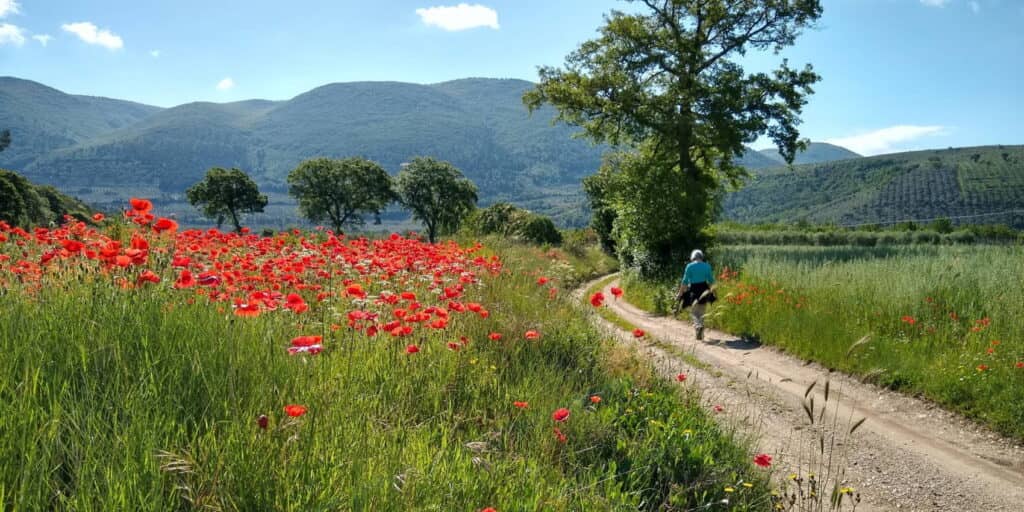Prices
In the footsteps of Saint Francis
Florence-La Verna-Sansepolcro-Città di Castello-Gubbio-Assisi-Spoleto-Rieti-Rome
The ‘Way of St. Francis’ is a pilgrims’ route to Rome passing all places which remind us of SAINT FRANCIS, locations that bear witness of his life. Since medieval times, there have been three famous Christian pilgrimage destinations: Jerusalem in the Holy Land, Santiago de Compostela in Spain, and Rome. The Way of Saint Francis crosses a part of Tuscany, Umbria from north to the south and finishes in the region Lazio, at St. Peter’s tomb in Rome. Every year many pilgrims and trekkers from all over the world follow this route through the silence of nature, passing unknown hermitages, sanctuaries, ancient forests, olive groves and valleys rich in art and history.
This pilgrimage walk begins in Tuscany, in the art town Florence. Walking through stunning landscapes you arrive at the monastery of La Verna. A spiritual place, where St. Francis received the signs of the stigmata (wounds of Christ). Through ancient woods, you pass small hermitages, famous monasteries and interesting towns, like Gubbio where he tamed the wolf. In Umbria, the native area of St. Francis, his presence is particularly strong and everything reminds us of the beloved saint. A highlight of this tour is of course the lovely town of Assisi, every street and square exudes a Franciscan atmosphere. It is the town where he was born and it is his final resting place. St. Francis’s tomb in the Basilica di San Francesco is one of the most celebrated sacred spots of Christianity. Assisi enjoys a splendid position on a hillside at a spur of Monte Subasio, overlooking the Valle Umbra and lying between the rivers Chiascio, Topino and Tescio.
St. Francis (1181/82 – 1226) was born in Assisi and lived here most of his life. It is certainly worth inserting an extra day in your itinerary to visit this fascinating town. Leaving Assisi you will walk through the wonderful countryside of Umbria, full of hills covered with woods, vineyards, and olive groves. You will pass through medieval towns and villages such as Spello, Foligno, Trevi, Spoleto, Ferentillo, and Arrone. You enter the region of Lazio and along with the approach to Rome, the landscape becomes flatter but no less exciting. On the last two days, you will walk through Rome passing monuments, which are worth visiting, but the highlight will certainly be the Basilica of St. Peter, the final destination of this walking tour!
Stretch W004 Florence – La Verna: 99 km /61,5 miles (6 walking days)
Stretch W005A La Verna – Città di Castello: 70,4 km / 43,7 miles (5 walking days)
Stretch W005B Città di Castello – Assisi: 100,9 km / 62,7 miles (5 walking days)
Stretch W005C Assisi – Spoleto: 67,4 km / 40,2 miles (4 walking days)
Stretch W005D Spoleto – Rieti: 86,4 km / 53,7 miles (5 walking days)
Stretch W005E Rieti – Rome: 108,4 km / 67,4 miles (6 walking days)
The daily program of Florence -La Verna (8 days)
The start of this walking tour is in Florence, a town to fall in love with ! Florence houses the most magnificent art treasures of the world. It is certainly worthwhile to book an extra night to explore the fascinating town.
Individual arrival at your hotel in Florence. At the reception, you will find your tour documents.
You leave the beautiful town of Florence following the old road “Strada dei Sette Ponti” (road of the seven bridges), which crosses the hills of the Arno. After Settignano with its historical villages, you walk between olive groves e vineyards and follow the river Arno. Your day ends in the fortified, intimate town of Pontassieve.
Distance: 22 Km/13.6 miles; walking time 7 hrs; Ascent/descent: + 600m -550m
Climbing, you cross the vineyards of the Chianti Rufina and then the woods of the Abbey of Vallombrosa until you arrive at the pass called Passo della Consuma. Consuma is a small, friendly hamlet
Distance: 19 Km/12 miles; walking time: 7 hrs; Ascent/descent: +1020 -140 m
Today a nice walk crossing the mountains of Casentinesi, a place for people who love to stay in nature. You pass through woods of conifers, oaks and chestnuts. Accompanied by nice views, you descend in the high Arno Valley (Alta Valle dell’Arno) and will have an overnight stay in the enchanting town of Stia. You can visit the church of Santa Maria Assunta, which dates back to the 12th century. In the old residence of the Guidi Counts, today there is an interesting collection of modern art.
Distance:16 Km/9,9 miles; Walking time: 5,30 hrs; Ascent/descent: +600 -1150 m
Again, you climb up to arrive at the woods of the national park Casentinese, which surrounds the hermitage Sacro Eremo di Camaldoli. The hermitage at 1100m height is a mystic place funded in 1012 by San Romualdo. After a visit, you continue your walk to Camaldoli village
Distance:16,5 Km/10,3 miles; Walking time: 7,5 hours; Ascent/descent: +1020 -580m
You walk continues through fir and beech woods. Then you reach the highest point of your journey (1354m) before you descend to the mountain village Badia Prataglia.
Distance: 8,5 Km/5,3 miles; Walking time: 3,5 hours; Ascent/descent: +540 -520m
Also today, the mountains will accompany you. After the climbing start, you have a long descend until you reach Rimbocchi in the Holy Valley “Valle Santa” Casentinese. Again, you climb up towards Monte Penne and reach the “crudo sasso” on which the impressive Monastery of la Verna is built. Saint Francis received here his stigmata, when he retreated from the world. Here you end our walk of today and it is also the end of the first stretch.
Distance: 17 Km/10.6 miles; Walking Time: 6 hours; Ascent/descent: +1200 -960m
After breakfast ends your walking tour from Florence to La Verna or you continue your walk along the Way of Saint Francis.
The daily program of La Verna -Città di Castello (7 days)
Individual arrival at your hotel in Città di Castello, a town situated in the Upper Tiber Valley and surrounded by a green landscape of rolling hills. It is a town bubbling with life and an important economical centre of the valley. Worth visiting are the municipal museum –with works by painters such as Raphael, Luca Signorelli, Giovanni and Andrea della Robbia, Pomarancio and Ghirlandaio- and the two museums dedicated to the works of Alberto Burri. On request you can start the tour also in the monastery of La Verna.
After breakfast you will be taken by vehicle to La Verna Abbey, built upon the mountain bearing the same name. At La Verna Saint Francis received the signs of the stigmata. Still remaining from this period are the small church Santa Maria degli Angeli and the cells of St. Francis and his companions. After your visit of the abbey you will start your first walk of this tour, climbing to the top of mount Calvano (1250 a.s.l.). From here you will have a magnificent view over the valley of Pieve Santo Stefano far below. You will then start your descent to this town. Pieve Santo Stefano is a town of Etruscan origin, but we don’t know much about its past because in the 19th century all the documentation was lost in a flood. Your overnight stay in a *** hotel is in the centre of town.
Distance: 14,6 km / 9,1 mi; Walking time: 4 ½ hours; Ascent / descent: + 264m, – 939m / max. height 1255m – min. height 436m
Today’s walk is long and leads you to the hermitage ‘eremo di Cerbaiolo’, the mountain pass ‘Valico di Viamaggio’ and the mountain village Montagna. Leaving Pieve Santo Stefano, the route climbs towards the hermitage. There is a saying: “whoever has visited La Verna and not Cerbaiolo has seen the mother but not the child”. Cerbaiolo is cradled against the mountain, surrounded by an oak wood. It was a dreary and abandoned place when Francis and his companions stayed here in 1216, but two years later, the first Franciscan monks came to live here and restored the hermitage. In 1230, St. Antony of Padua also stayed for a period in Cerbaiolo. The route continues climbing up to the Valico di Viamaggio and further to the top of Monte Verde. Then follows a well-deserved descend towards the village of Montagna. Your overnight stay is in a B&B Montagna
You could shorten the route with about 5 km to take in the morning a transfer to the Eremo di Cerbaiolo (about € 40,00 for the ride)
Distance: 23,1 km / 14,4 mi; Walking time: 6 hr 20 min; Ascent / descent: +919m – 689m / max. height 1149 – min. height 440m
Today a nice walk is awaiting you through woodland with occasional clearings, from which you can enjoy amazing views over the surrounding hills and mountains. Your descent continues towards the monastery of Montecasale, where once was a tavern for pilgrims on their way to the Holy Land. Francis stayed here several times and praised the silence of this place. After another 5 km downhill walk, you will reach Sansepolcro, the birthplace of the painter Piero della Francesca, whose famous painting ‘The resurrection’ can be admired in the town’s museum. Also worthwhile visiting is the cathedral. You will stay in a B&B or a 4 **** hotel.
Distance: about 11,7 km / 7,3 mi; walking time: 4 hours; Ascent / descent: + 234m, – 579m / max. Height 790m – min. height 332m
Today’s walk is shorter and with less climbing and descent. This gives you the opportunity to visit Sansepolcro and Citerna. Leaving Sansepolcro you cross the fertile Tiber valley and after the hamlet of Bastia you enter the region of Umbria. The terrain becomes more hilly and the route climbs through the woods to the town gate of Citerna, a small medieval town, which is listed as one of the most beautiful villages (borghi) of Italy. After your visit of Citerna there will be a last climb through olive groves and chestnut woods till the farmhouse B&B or hotel *** with breakfast and dinner.
Distance:17,6 km / 11 mi; Walking time: 5 hours; Ascent /descent: + 500m – 282m / max. height 511m – min. height 274m
After breakfast, you will start the last stretch of this tour to Città di Castello. You walk through a hilly landscape with oak woods and agricultural fields. Just before arriving in Città di Castello you will pass the hermitage del Buon Riposo, built on the spot where St. Francis stayed in a cave during his journeys to La Verna. Now it is private property. The last stretch of descent will take you past Villa Montesca, where Maria Montessori taught teachers her education method. Across the bridge over the Tiber you enter into the centre of Città di Castello. Overnight stay in **** hotel in the centre of town
Distance:15,1 km / 9,4 mi); Walking time: 4 hours; Ascent / descent: + 440m – 656m / max. height 530m – min. height 274m
After breakfast ends this tour or you continue your walk along the Way of Saint Francis.
The daily program of Città di Castello - Assisi (7 days)
Individual arrival at your hotel in Città di Castello, a town situated in the Upper Tiber Valley and surrounded by a green landscape of rolling hills. It is a town bubbling with life and an important economical centre of the valley. Worth visiting are the municipal museum –with works by painters such as Raphael, Luca Signorelli, Giovanni and Andrea della Robbia, Pomarancio and Ghirlandaio- and the two museums dedicated to the works of Alberto Burri.
The walk of today is long and you can shorten it by asking for a transfer. Then after breakfast, you will be taken by vehicle to Moun Sasso to begin a beautiful walk through Umbrian hills. Of particular interest today is Pieve de Saddi, one of the earliest Christian communities in the Upper Tiber Valley (3rd century a.C.). Your walk today finishes at Pietralunga, a small town built on a hilltop. At the main square, you can see the remains of the Longobard castle. Your overnight stay is in a B&B or hotel *** in the centre of Pietralunga
Distance: 30,5 km / 19 mi or 21,1 km /13,1 mi; Walking time: 10 or 7 hours; Ascent / descent: + 864m – 619m / max. height 660m – min. height 286m
Today another spectacular walk awaits you, with beautiful views of the surrounding hills and mountains. You will pass the Abbey of San Benedetto and will climb and descend to reach the high plain of Gubbio, where the town itself is built proudly on the slopes of Monte Ingino. Gubbio not only offers fascinating cultural sights but is also a lively town with small shops, excellent restaurants and cosy squares. Gubbio is closely linked with the life of St. Francis, who came here as a beggar. In this town, he found shelter thanks to his friend the textile merchant Spadalunga, who not only gave him a place to sleep but clothes to dress. This simple straight dress became the prototype of the Franciscan tunic. The church and monastery of St. Francis is built on the site of Spadalunga’s house. You will stay in a hotel near the church of St. Francis. The hotel *** hotel is situated in the historical centre of the town. On request it is possible to upgrade to a **** hotel
* this day could be divided in with an overnight stay in Loreto in a B&B with breakfast and dinner. The route distances would be 14,6 km /9 mi -10,6 km / 6,6 mi
Distance: 25,2 km / 15,7 mi; walking time: 8 hours; Ascent / descent: + 621m, – 671m/ max. height 781m – min. height 399m
In Gubbio starts the ‘Sentiero della Pace’ (Peace path) which leads to the castle of Biscina. In the beginning a steep climb brings you out of the valley of Gubbio. Today you will have beautiful scenery and you will pass the small church of Caprignone, the hermitage of S.Pietro in Vigneto and the chapel Madonna delle Ripe. The route ends at a holiday farm near the Castle of Biscina.
Distance: 22,8 km / 14,2 mi; Walking time: 7 hours 15; Ascent / descent: + 593m, – 546m/ max. height 668m – min. height 320m
Also today an uphill downhill walk through the hills between Assisi and Gubbio. You will pass the small churches of Sambuco and Coccorano and walking along the Chiascio River you will arrive at Vallfabbrica. Your overnight stay is in town in a B&B or on request just outside in a holiday farm
Distance:15,5 km / 9,6 mi; walking time: 5 hr 15; Ascent / descent: + 306m – 550m / max. height 615m – min. height 330m
This last stage will see you walking through forest and olive groves to Assisi. From afar you will already be able to see the castle and the basilica of St. Francis. Near the bridge Ponte Croce, you can make a short detour and walk in the ‘Forest of St. Francis’ with the small church of St.Croce, the ‘Ponte dei Galli’ (the bridge where is said that Charles the Great passed) and an old mill. A last steep climb and you will pass through the town gate known as Porta S.Giacomo. Descending from here you will have an astounding view of the upper church of St.Francis. On the way to your *** hotel you will cross the town centre, passing the most famous Franciscan monuments. On request you can stay in a religious house or upgrade to a *** or **** star hotel.
Distance:16,3 km / 10,1 mi; Walking time: 5 hours; Ascent / descent: + 512m – 423m/ max. height 560m – min. height 266m
After breakfast ends this tour or you continue your walk along the Way of Saint Francis.
The daily program of Assisi - Spoleto (6 days)
Individual arrival at Assisi. If you arrive in good time you can go for a cultural walk through Assisi. The route passes the Basilica di San Francesco, the house where the saint was born, the Basilica di Santa Chiara and the monastery of San Damiano, where Francis wrote the famous ‘Cantico delle Creature’. You stay in a *** hotel, but on request you can have an overnight stay in a religious house, in a *** or **** star hotel
You leave Assisi by the Porta Cappuccini town gate and here you will enter immediately into the woods of the Natural Park of Monte Subasio. A steep climb will take you up to the hermitage ‘Eremo delle Carceri‘ (830m), one of the places which best captures the ‘sense’ of the prayers of St. Francis, who used to retreat here with his most faithful companions to pray and meditate in the silence of the woods. Originally, there were some little grottos in the rock, a small oratory and some mud huts. After the saint’s death, a small monastery was built. You can visit the cave where St. Francis slept and the ‘devil’s hole’ which is a reminder of his temptation.
From the hermitage, you will descend towards Spello, passing the abbey of San Benedetto with its beautiful 11th-century crypt. The descent continues and the woods become less and less dense and then give way to olive groves. The village of Spello clings to the hillside. It was once a Roman castrum. Several Roman features remain, including three town gates, the remains of an amphitheatre and some beautiful mosaics. The streets and alleyways are steep, winding and often adorned with flowers. Don’t miss the church of Santa Maria Maggiore, with its beautiful Baglioni chapel decorated with frescoes by Pinturicchio. The church of S. Andrea contains the remains of the Franciscan monk Sant’Andrea Caccioli, born in Spello in 1194. He also had a cave for prayer and meditation at the ‘Eremo delle Carceri’. Your accommodation is in a *** star hotel in the old town centre. On request, you can upgrade to a **** hotel
Distance: 16,8 km / 10,3 mi; walking time: 5 hours; Ascent / descent: + 759m, – 832m
After breakfast put on your backpack, walk down through the centre of Spello and leave the town by the town gate Porta Consolare. A walk along the valley will take you to Foligno, which is one of the few towns built in the valley rather than on the hills. Cross the bridge over the river Topino and you enter into the old town centre. It has some nice monuments to visit: an impressive cathedral with two Romanesque façades (12th century), the 14th century Palazzo Trinci, which hosts both an archaeological museum and an art gallery and the Oratorio della Nunziatella (1494) with a fresco by Perugino. Leaving Foligno you will also leave behind the sounds of the town, because at Sant Eraclio the route enters the olive groves once more. You will remain among olive trees from here to Trevi. Passing small hamlets and villages with narrow streets, a last climb will take you into Trevi, which dominates the valley from its hilltop position. Francis went to Trevi several times. Your overnight stay is in a *** hotel.
This day could be shortened taking the train from Spello to Foligno or with an extra overnight stay in Foligno in a *** hotel
Distance: 19,9 km / 12,3 mi; Walking time: 6 hours; Ascent/Descent: + 351m -236m
Today’s route is not very long, but involves plenty of uphill and downhill stretches on hills covered with olive groves and woods. You climb to an old Franciscan hermitage which now houses an enclosed order, then you descend through the olive groves before walking up to Campello Alto, at 514m above sea level. This is a fortified hill village built in 921 by Rovero di Champeause, baron of Burgundy. You will stay in a ** hotel, or on request in an ex-convent or you can stay also in a Relais in the old Borgo Campello Alto.
Distance: 11,7 km / 7,3 mi; Walking time: 3 hours 40; Ascent / Descent: + 511m -274m
You descend to return to pick up the Way of St.Francis in Campello alto. In Poreta you follow the lower route and will have a nice view of the Castello di Poreta Walking through olive groves you will come to Osteria where there was once a hotel for pilgrims. A steep climb brings you to Bazzano superiore, and then passing the remains of a castle you will come down to Bazzano inferiore. After a tiring climb in the woods you will emerge into the olive groves above Eggi, which is built on the top of a small hill and has a 14th-century castle. A quiet country lane brings you to Spoleto, once a Lombard duchy. Spoleto is a proud medieval town, with a beautiful cathedral (il Duomo) and an impressive castle that dominates the town from above.
Spoleto played an important role in the conversion of Saint Francis, who was on his way to Apulia seeking a glorious future as a knight when he stopped to rest in Spoleto. When he was half-asleep he heard a voice asking “Who can be more useful to you: the master of the servant?”. Francis replied “The master”. The voice said “Why then do you abandon the master to follow the servant, and the prince to follow his subject? Go back to your home town and there you will be told what you must do…”. Your hotel *** is situated in the historical centre of Spoleto. On request we can book a **** star hotel or a religious house
Distance: 19 km / 11,8 mi; Walking time: 5 hrs or 7 hrs; Ascent / Descent: + 650m -727m
After breakfast ends this tour or you continue your walk along the Way of Saint Francis.
The daily program of Spoleto - Rieti (7 days)
Individual arrival in Spoleto.
Spoleto has a nice old town centre If you arrive early you can already explore the town. There is a lot to see such as the Duomo with frescoes of Filippo Lippi and Pinturicchio, a Roman house, the archaeological museum and the town museum. Your hotel *** is situated in the historical centre of Spoleto. On request we can book a **** star hotel or a religious house.
Today a short walk, but it goes always uphill. In the morning, you have still time to visit Spoleto.
The serious climbing starts at your hotel. Before leaving Spoleto you will pass the cathedral with its beautiful frescoes by Filippo Lippi. It was here that in 1232 Pope Gregory IX declared Anthony of Padua saint (or Anthony of Lisbon). Also shown here is the letter that Francis wrote to Friar Leo. Continuing uphill, after the castle (the Rocca di Spoleto) and the bridge known as the Ponte delle Torri (13th century) you enter the ‘sacred’ woods of Monteluco. These woods were recognized as having a mystical atmosphere even in ancient times and were treated with fear and respect. In the first centuries of Christianity, hermits came to these woods and settled here. St. Francis was also attracted by the mysticism of the place and in 1218 the Franciscans built a small sanctuary here. Inside this monastery is the dwelling of St. Francis, now a chapel, and the tiny cells of the monks. To the left of the building is the grotto of Saint Anthony of Padua, which is closed with a gate. Continue on the ‘Sentiero di Pio IX‘ (the path of Pope Pius IX) which in 1831, before becoming Pope, he used to escape from the pillaged town. Still climbing, you will reach the highest point of today’s route at the pass of Castel del Monte, where you will leave the Via di San Francesco to go to the hamlet Patrico, where is your farmhouse B&B with restaurant (1040m a.s.l.).
Distance: 9,7 km / 6 mi; walking time: 3 hours 45; Ascent / Descent: +766m -217m
After breakfast, you leave the peaceful farmhouse and walk back to Castel del Monte to pick up the route. From here, you begin the descent into the Valle del Nera. You will be walking in the woods and pass the abandoned village of Sensati. In the Nera valley, the route becomes flatter and you will follow the river, which winds along finding its own way until Ferentillo. You stay in a ** hotel. On request you can stay in the abbey of S.Pietro in Valle
Distance: 21,1 km /13 mi or 24 km /14,9 mi (visiting the abbey S.Pietro in Valle); Walking time: 6 hours; Ascent / Descent: +219m -952m
Leaving Ferentillo, you continue to follow the river Nera. Just before the ‘Cascate delle Marmore‘ waterfalls, the path climbs through the woods up to the highest point of the falls, which are artificial and were created during the Roman period. You will reach the lake of Piediluco without any climbing. It is said that St. Francis visited Piediluco several times on his journeys to Rome or Rieti. To remember these visits, in 1298 the Franciscans began building a church here, which was completed in 1338. You have an overnight stay in a *** hotel on the lakeshore.
Distance: 19,9 km / 12,4 mi; Walking time: 5 ½ hours; Ascent / Descent: +408m -297m
Today’s route is scattered with places of interest, like the town of Labro, which is evocative, charming, and very well kept. You can go directly to Poggio Bustone or extend the route and walk towards Francis’s beech: a tree so well-loved that it has itself become a little living sanctuary. The beech tree is famous because it is said that the tree assumed this shape to shelter Saint Francis from a storm, which took him by surprise during a solitary retreat. The last stretch takes you on a shortcut downhill on mule tracks to the village of Poggio Bustone. “Good day to you good people!” is how Francis greeted the surprised villagers of Poggio Bustone, when he entered the town through the lower gate in 1208. Francis slept in a cave in the rocks. Here an angel in the form of a young man appeared to him, reassuring him that his sins would be forgiven: “ Do not torment yourself, oh Francis, for your sins will be forgiven as you have asked God”. The church is known as ‘Sacro Speco‘ (the ‘Holy Cave’) and was built partly in the 14th and partly in the 17th century. The sanctuary at Poggio Bustone as we see it today is the result of various stages of building and rebuilding work over the course of the centuries. The oldest, original part is a small convent, which dates back to the 13th century. You will stay in Poggio Bustone in the old centre of town. In case the B&B has no availability you will be transported by vehicle to a **** hotel in Rieti.
Distance: 18,7 km /11,6 mi; Walking time: about 5 ½ hrs; Ascent-Descent: + 838m -489m
If you don’t have your overnight stay in Poggio Bustone, after breakfast you will be brought back by vehicle to Poggio Bustone. Today’s walking takes you to Rieti, passing through the enchanting Cantalice and the sanctuary of La Foresta. You pass not far from Monte Terminillo, on which you have a nice view. The first village you come across is Cantalice, which is perched on a hill with the houses overlapping right up to the highest point where the Torre del Cassero stands proudly. This village was the birthplace of San Felice di Cantalice, who is remembered for the miracle of the water source, said to have taken place in the spot where the sanctuary of S. Felice dell’Acqua stands today. The next section of the Via di Roma will take you to the sanctuary of La Foresta. In the summer of 1225, on the invitation of Cardinal Ugolino, Saint Francis stayed here for 50 days to treat his eyes.
After about 5 hours of walking, you will arrive in Rieti, your final destination of this stretch. Rieti is surrounded by greenery and enjoys a pleasant coolness thanks to the waters of the river Velino. You will be able to wander around the streets of this splendid town and enjoy a tasty dinner in one of the many characteristic local restaurants. Your overnight stay will be in a **** hotel in the town centre.
Distance: 17 km / 10,6 mi; Walking time: 5 hrs 10 min; Ascent-Descent: + 288m -624m
After breakfast ends this tour or you continue your walk along the Way of Saint Francis.
The daily program of Rieti - Rome (8 days)
The town centre of Rieti rests on a small hilltop, commanding a wide plain at the southern edge of an ancient lake. The area is now the fertile basin of the Velino River. Rieti, the Sabine Reate, is a quiet town with many interesting sites. A part of the town is still surrounded by the town walls with characteristic round and square towers and it has five town gates. Worthwhile to visit is the roman cathedral Santa Maria with beautiful frescoes, the 13th-century Sant’Agostino church, the 13th-century S.Francesco church and the palazzo vescovile (“Bishops Palace”), whose construction began in 1283. Noteworthy is the loggia and eight Renaissance-style windows from 1532. You stay in a **** star hotel in the town centre.
Leaving Rieti today you will get to know a part of the Via Salaria (the Salt Road) which connected in Roman times the Tyrrhenian coast with the Adriatic coast. Along the way, you will come across the pretty medieval village of Ornaro Alto and the characteristic medieval village of Poggio San Lorenzo. The name of this village probably derives from the 4th century when Sant’ Emidio stopped here to preach about the martyrdom of San Lorenzo (Saint Lawrence). Sant’Emidio’s words made such a mark on the people that they decided to rename their village. The village centre and the town walls date back to the Roman period. You stay in a Holiday farm ‘agriturismo’ with a restaurant and swimming pool
Distance:21,7 km /13,5 mi; Walking time: 6hrs; Ascent and Descent: + 533m -412m
The scenery is particularly beautiful today thanks to the combination of ancient oaks, the archaeological area of the ancient Sabine town of Trebula Mutuesca and the church of Santa Vittoria, which rises up on the hillside. Vittoria is said to have been a Roman noble girl who lived in the 3rd century AD and refused to wed a rich patrician. She consecrated herself to God. She died in exile in Trebula Mutuesca, where her sarcophagus is now housed in a church. Continuing on your way you will reach the village of Poggio Moiano, which rests at the foot of Mount Moiano. This village is famous for the floral pictures created for the solemn procession during the Feast of the Most Sacred Heart of Jesus. Also in the area protected by the Lucretili Mountains is the village of Scandriglia, another little marvel that you will encounter today. Several places are worth visiting in Scandriglia: the 15th century Palazzo degli Anguillara is a grand building with fine renaissance architecture and some late gothic features. Preserved in the building are some frescoes ascribed to the school of Antoniazzo Romano. You will have an overnight stay in a B&B.
Distance: 21,1 km /13,1 mi; Walking time: 6 hrs 25 min; Ascent-Descent: +570m -748m
Today is a short day with not too much climbing. The route crosses the road for Nerola, where you can visit the Orsini castle, which is perched on a high rocky outcrop. Through the countryside, you go up to Montelibretti with its 10th century Palazzo Barberini. You can still see the defence walls of the town with lookout towers. The olive mills of Montelibretti might tempt you in for an olive oil tasting. Your overnight stay is in a B&B close to the old centre of town
Distance:14,3 km / 8,9 mi; Walking time: 4 hrs; Ascent-Descent: +292m -389m
You leave Montelibretti and soon the olive groves of the hills give way to vast orchards. At the end of your day’s walking the Via Salaria will lead you to Monterotondo, where there is plenty to see: the basilica of S. Maria Maddalena (17th century), the church of Madonna delle Grazie (14th – 15th century) and the Palazzo Orsini-Barberini, where you can admire the dining room frescoed by the Flemish artist Paul Brill. Your overnight stay is in a *** hotel in the centre of Monterotondo.
Distance: 17,4 km / 10,8 mi; Walking time: 5 hrs 15 min; Ascent-Descent: +233m -316m
Today the route is mostly flat. You will enter the Natural Park of Marcigliana, a protected nature reserve that preserves all the charm of the Roman countryside with its gentle hills and valleys marked by deep ditches. The site of one of the most ancient towns of protohistoric Lazio, Crustumerium, was discovered here in the Marcigliana area. Leaving the Park behind you will find yourself approaching Rome, the climax of the Via di Roma. Suddenly the green will take place for the town of Rome. The end of today’s walk brings you to Montesacro, a district of Rome founded in 1924. Among the places of interest is the Acqua Sacra water spring where many Romans come to fill up their bottles with mineral water straight from the source. You stay in a *** hotel.
Distance: 18,5 km / 11,5 mi; Walking time: 5 hrs; Ascent-Descent: +245m -343m
We should say so many things about today’s route! There is so much to see that it would take an entire guidebook to sum it up. You will pass near the Mosque and the ‘Parco della Musica‘ auditorium which hosts the big musical events of Rome. You will cross one of Rome’s oldest bridges, the Ponte Milvio (4th -3rd century BC). Continue along the right bank of the Tiber to the beautiful Ponte Sant’Angelo bridge, which since medieval times has been the most frequented route for pilgrims heading for Saint Peter’s. Pass Castel Sant’Angelo and finally… perhaps tired but surely satisfied, you will walk along Via della Conciliazione to reach the impressive Basilica of Saint Peter, in the crypt of which is St. Peter’s tomb: the end of your journey. YOU DID IT ! You will have an overnight stay in a *** hotel near the Vatican.
Distance: 15,5 km / 9,6 mi; Walking time: 4 hrs 15 min; Ascent- Descent: +60m -86m
After breakfast ends this tour along the Way of Saint Francis.
Impressions of the Way of Saint Francis
LEVEL 3 – 3,5
For walkers with experience and good physical condition. Routes through hilly landscapes and walking in middle mountainous terrain with significant up- and downhill walking. Daily distances between 14 and 28 km. An average of 3 km an hour. You will walk on footpaths, mountain tracks, forest trails and on quiet country roads.
Average daily distances:
between 10 – 30 km.
Total km:
Florence – Rome: 528,5 km / 328,4 miles
DEPARTURES:
Daily from 1st April until 15th October 2024 (except 04/08-18/08/2024)
PARTICIPANTS:
1 or more people.
START / FINISH:
Florence / Rome
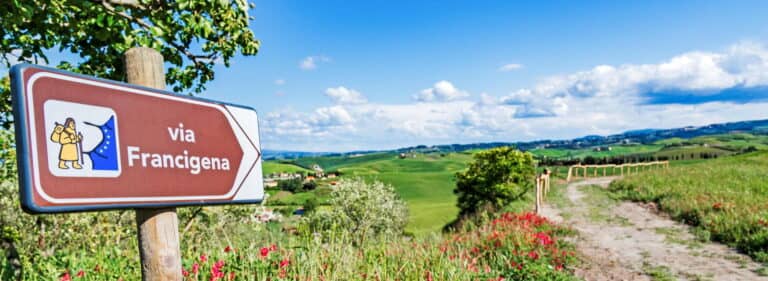
Via Francigena: Lucca -Siena-Viterbo-Roma
Walking from Luca to Rome along the Via Francigena, an ancient pilgrims way, enjoying the panoramic landscape and picturesque towns of Tuscany and Lazio.

